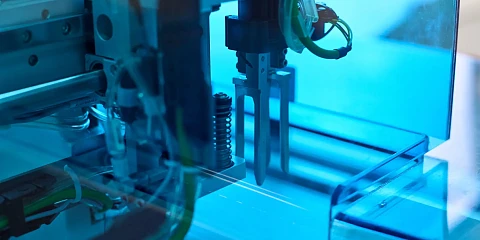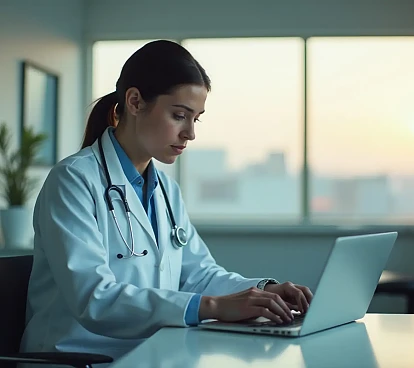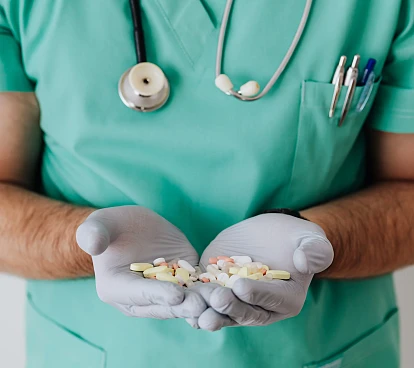
Interview with Trinidad de Frutos
November 20, 2023
Trinidad de Frutos, Scientific Medical Advisor. She has a degree in biology, specialized in biochemistry and molecular biology, and a Ph.D in medicine. She also has a Certificate of Pedagogical Aptitude and Secondary Teacher Training, a master’s in Clinical Trials Monitoring and a master’s of entrepreneurship. She volunteers at COVIDWarriors and collaborates with ConectemosYA.
Which digital technologies do you think are going to contribute the most to the healthcare field in the coming years?
The pandemic forced us to face such a tremendous challenge that it has changed many facets of our lives — the way we perform daily activities, the way we collaborate and, of course, the pace and impact of digital technologies in the healthcare sector.
With the pandemic people, perhaps more than ever, valued the importance of health, as well as the quality, usefulness and origin of Covid-19-related data and information. Before the pandemic, we thought the implementation of certain digital technologies was much further away than we do now. That’s because of the needs that have arisen, the regulations and recommendations that have been published in recent months and the significant increase in financing for projects in the healthcare sector that use these technologies.
In my opinion, the digital technologies that will contribute the most in the coming years to the healthcare sector are:
- Blockchain for its advantages in interoperability, security, privacy and data governance, to name a few. It has an especially relevant role in the implementation of digital identity in health.
- The combination of AI, big data and machine learning for their multiple applications in science and health. This includes everything from diagnostic improvement, the creation of triage tools, algorithms, predictive models and computer alerts to improve the comprehensive quality of care. They could also play a huge role in drug research and development, helping researchers identify targets and find molecules related to those targets or the repositioning of drugs that also act at that level, process improvement, international collaboration and secure access to large databases for analysis.
- Digital technologies that allow for the appropriate use of telemedicine. Whether it’s appropriate could depend on the time, person and place. There are also the technologies that promote the humanization of comprehensive patient care, taking into account patients’ situations, accessibility and preferences. Technology that allows patients to receive and provide feedback on their experiences, quality of life, healthy habits, environment and social support, etc. and can integrate that information into clinical histories is also highly interesting. But, as with everything, it must guarantee standards of good practices, reliable use, respect for privacy, equity, cybersecurity and other applicable regulations, while also allowing for collaboration between the different professionals who serve the patients.
I’d recommend reading some of the following references for more information:
- WHO SMART guidelines: optimising country-level use of guideline recommendations in the digital age - The Lancet Digital Health
- Prospective dialogue between developers and regulators makes for better evidence generation | European Medicines Agency (europa.eu)
- The OECD Artificial Intelligence (AI) Principles - OECD.AI
Do you believe that the healthcare sector is currently doing as much as it can with the technological innovations that are already available?
Although a lot of new initiatives have been rising to the surface lately, there’s still a huge margin to use technology to improve the healthcare sector.
Internationally, you have collaboration initiatives like the European Connected Health Alliance (ECHAlliance) that helps connect 78 countries. It has more than 16,000 experts involved in innovative areas like global health, digital health and basic areas like quality of health and social care. In their 2020 report, they sum up different projects that they’ve been working on and their plans for the future. This includes things like the Digital Health Observatory and the Digital Health Society, which facilitate and promote knowledge transfer and best practices while creating a global community based around digital health.
Another European example is Digital Health Europe, which acts as a support for the large-scale implementation of digital solutions that help offer integral patient care that is centered around people.
The digital maturity of healthcare systems in each country has a huge influence on where they are in terms of digital technology. In Spain, a study has ranked that maturity level as average/low with a 31% variance between the different regions. We have the opportunity to bridge that gap and digital technologies can help. It seems like the moment has arrived because this digital transformation is receiving a new wave of public funding.
The Spanish Federation of Health Technology Companies (FENIN) has proposed a nationwide project to digitize the healthcare sector over the next few years, which is based on interoperability and data governance, a common space for shared data, boosting collaborative R&D, renovating technology, etc. In Spain, at the moment, the healthcare systems are operated by decentralized regional governments, so this is very interesting. I believe that it’s a great model, especially in terms of its push for co-design between patients and doctors in terms of the projects. That’s because doctors and patients know the system and its needs very well. Designing this transformation not only from top-down government agencies is critical for creating value-added services that truly improve processes and the quality of care.
What do you view as the main challenges in the healthcare system today that technology can help overcome?
There are a lot of challenges and they’re very complex. It will take a multidisciplinary approach to overcome them. Here, I’ll name a few that I believe are most relevant, also drawing from the opinions of leading organizations like the WHO, the European Medicines Agency (EMA), the European Commission and the Global Health Digital Partnership.
- Stop the spread of health-related misinformation. The WHO has established criteria for managing so-called infodemics that help orientate us to the problem. One example is the platform SYNCHROS that coordinates and supports the synchronization of studies and surveys in both the European and global populations. We’ve worked on some initiatives as well at COVIDWarriors to help improve health information and fight misinformation. The EpidemiXs platform shares validated and contrasted information related to COVID-19 and won a Barcelona Health Hub Prize for its role in COVID-19. In Spain, we also have Maldita.es, which won a European journalism prize for similar work.
- Guarantee privacy, safety and compliance with data protection laws in the creation of a Digital Health Identity. This would allow all citizens to be able to access their personal health records and decide how they are used. The European Commission recently proposed creating this type of ID. Here, the use of blockchain is key. There are other initiatives like ID_Alastria or Unid, although they still haven’t been implemented at a national level.
- Guarantee the quality, security and privacy and interchange of healthcare data to enhance patient care, scientific investigation and policymaking. The European Commission wants to create a European Health Data Space with eHealth infrastructure and information standards for just those reasons. It wants to be able to make a system that securely and efficiently shares data among relevant parties. There’s still a long way to go in making this happen, especially in Spain.
- Equal quality and access to health services for everyone and at different times and places. Balance and humanize the use of telemedicine based on the needs and preferences of the patient. But we have to be careful here. In some towns in Spain, healthcare jobs are being eliminated, alongside almost all face-to-face visits. If we add the digital divide (people who don’t know how to use or don’t have access to the digital space), assistance is limited to phone calls. This must be avoided. One good example of telemedicine is telematic cardiac rehabilitation that enhances the continuity of cardiology care-primary care and fosters the involvement of the patient. There’s also the Fundación Humans, which facilitates processes of humanization in health organizations, in professional attitudes and in the organizational processes of healthcare centers. I’d also highlight remote telemonitoring with HumanITcare, a customizable AI tool that unifies data from different medical devices and sends out alerts to improve patient monitoring.
- Implement value-based medicine that facilitates the improvement of monitoring processes and comprehensive patient care. For example, I find it interesting that the IMI (Innovative Medicines Initiative), a public-private partnership in the European Union, has launched the Health Outcomes Observatory (H2O), a multi-jurisdictional ecosystem to incorporate health outcomes and other information reported by patients for healthcare decision-making in Europe. Establishing standardized processes to simply analyze data from recommendations, good practices, surveys/questionnaires for patients, information from doctors or pharmacists about each pathology is promising. Using data visualization to display the information, whether related to an individual or groups, can help decision-making and multidisciplinary management. Groups like HOPES, in collaboration with SEDISA and other entities including health professionals and patients, are beginning to implement this strategy in pilot projects focused on specific diseases in some Spanish hospitals.
- The development of health technology within the WHO framework and the new EMA legislation on the use of medical devices. This includes sensor assessment, mobile health (mHealth) tools, telecare in clinical trials, health data analysis (i.e. data processing systems that support bioinformatics modeling) and digital record systems (i.e. digital apps that work as patient diaries). Some organizations such as ORCHA (Organization for the Review of Care and Health Apps) help establish quality criteria for health and well-being apps. There are many more in the pipeline, so knowing which are the most useful is another challenge.
- The ability of people to interact with others who have similar pathologies and participate in online support communities. At the Plataforma de Pacientes, which brings together more than 1,400 patient associations, they are doing a great job at this. Other initiatives such as Share4rare or Connect4children propose different ways of helping people with rare diseases. It is also important to promote healthy lifestyles, which can certainly be done through digital tools.
- Improve early diagnosis, establish predictive models for disease evolution, digital triage/alerts that facilitate both diagnostics and disease monitoring and intervention at critical moments. This article in Nature: https://www-nature-com.eu1.proxy.openathens.net/articles/s41746-020-00333-z touches on some of these use cases.
- Improved pharmaceutical development and research. Technology is already assisting with the following processes: the identification of therapeutic targets, search for possible molecules, drug repositioning, speeding up clinical trials, optimizing administrative and manufacturing processes, etc. Several of these examples are explored in this paper: Gupta R et al. Mol Divers. 2021;12:1–46.
- Attracting financing into the fields of health and science. National and international funding for technology and health has increased significantly. But it’s still a challenge to make the most of it with projects that are collaborative, multidisciplinary and for the common good. It’s another challenge to make administrative processes and monitoring more agile. Besides state funding, there are also funding projects like EitHealth, CapitalCell or crowdfunding through EpidemiXs Studies.
- In professional training and support. Technology opens the door to new models. The Fundación Recover comes to mind, which connects African health professionals with Spanish doctors through a social network for training and support.
I’ve named several examples, but this list is by no means exhaustive. There’s a lot more to explore and now is a truly exciting time to witness the convergence of health and technology.
Our latest news
Interested in learning more about how we are constantly adapting to the new digital frontier?

Tech Insight
March 5, 2025
AI Governance: Challenges and Perspectives

Insight
February 18, 2025
The Transformative Power of AI in Health and Pharma

Tech Insight
February 11, 2025
Unlocking the tech potential in international pharmaceutical tender management

Insight
February 5, 2025
Pharmaceutical tenders: top 5 obstacles and how to overcome them